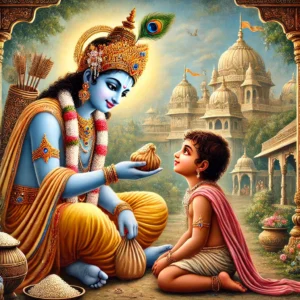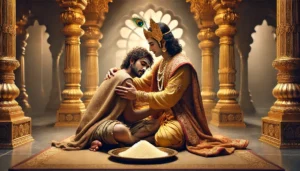
Story of Sudama and Krishna as Prosperity
Sudama and Krishna: A Tale of Friendship and Wealth Management
The timeless story of Sudama and Krishna is not just a lesson in friendship but also a metaphor for wealth, humility, and financial wisdom. This ancient tale, rooted in Indian mythology, has deep moral and philosophical insights that remain relevant even in today’s fast-paced financial world. It illustrates how true wealth goes beyond material riches and how wise financial management, combined with a generous heart, can lead to a fulfilling life.
The Story of Sudama and Krishna
Sudama, also known as Kuchela, was a poor Brahmin who had been a close childhood friend of Lord Krishna. They studied together at the ashram of Guru Sandipani, sharing their meals and hardships. However, their paths diverged—Krishna became the mighty ruler of Dwarka, while Sudama remained a humble priest, struggling with extreme poverty.
The Visit to Dwarka
Encouraged by his wife, who saw no other way out of their dire situation, Sudama decided to visit Krishna in Dwarka, hoping for assistance. As a symbol of their bond, he carried a simple gift—a small bundle of beaten rice (poha), which was all he could afford. Despite his financial struggles, Sudama hesitated to seek help, as he valued friendship over material gain.
Upon reaching Krishna’s grand palace, Sudama was overwhelmed by its splendor. However, Krishna, upon seeing his childhood friend, rushed to embrace him, treating him with the highest respect and love. Ignoring the opulence of his surroundings, Krishna seated Sudama with honor, washed his feet, and made him feel at home.
When Sudama shyly offered the small bundle of poha, Krishna accepted it with immense joy, eating it as though it were the most delicious meal he had ever had. The gesture signified the importance of love over wealth—a key lesson in financial and emotional well-being.
Sudama’s Reward: The Power of Divine Blessings
Despite his wife’s expectations, Sudama could not bring himself to ask for financial help. However, Krishna, being omniscient, understood his friend’s hardships. When Sudama returned home, he was astonished to find that his small hut had transformed into a grand palace, and his family had been freed from the chains of poverty. Krishna, without making it seem like a favor, had blessed Sudama with abundance.
This transformation teaches a powerful lesson about how true wealth is often a byproduct of genuine relationships, sincerity, and unwavering faith.
Table of Contents

Story of Sudama and Krishna as Prosperity
Wealth Management Lessons from Sudama and Krishna
While this story is often seen as a moral or spiritual lesson, it also offers valuable insights into wealth management and financial wisdom. Let’s explore some of the key takeaways:
- The Power of Relationships Over Wealth
Sudama and Krishna’s friendship highlights that relationships are more valuable than money. In today’s financial world, strong relationships, networking, and goodwill can often lead to greater success than mere financial transactions. Trust and emotional wealth can often bring opportunities that money alone cannot buy.
- Giving Without Expectations Brings Unexpected Rewards
Sudama’s humble gift, despite being of little material value, was given with a pure heart. This mirrors the principle of giving in finance—whether through charity, mentorship, or goodwill investments. When wealth is shared with a selfless attitude, it often leads to unexpected and greater returns, both spiritually and materially.
- Wealth Is Not Just About Money
Krishna’s blessing to Sudama teaches that wealth is not merely about accumulating gold, land, or money. True wealth includes:
- Financial security – Ensuring that basic needs are met
- Good health – As without health, money has little value
- Emotional well-being – As happiness is not always tied to wealth
- Strong relationships – Because support networks are invaluable
This is a crucial reminder that financial success should be measured in holistic terms, not just bank balances.
- The Role of Divine or Unexpected Rewards in Wealth Creation
Sudama did not explicitly ask for wealth, but his faith, sincerity, and humility led him to receive divine rewards. In modern financial planning, this can be equated to:
- The power of long-term investments – Patient and disciplined investors often see exponential returns over time.
- Karma and ethical wealth-building – Ethical business practices and fair dealings often attract sustained success.
- Unexpected opportunities – Sometimes, wealth comes in ways we do not anticipate (inheritance, business breakthroughs, sudden market upswings).
5. Managing Wealth with Humility and Responsibility
After receiving immense wealth, Sudama remained humble and continued to lead a simple life. This teaches us that financial success should not lead to arrogance or unnecessary extravagance. Practical takeaways include:
- Living below your means – Even when wealthy, avoid unnecessary splurging.
- Investing wisely – Wealth should be sustained and grown responsibly.
- Giving back to society – Prosperity should be shared through philanthropy and community service.
A well-managed fortune ensures long-term security rather than short-lived luxury.
Unlock the Ancient Wisdom of Sanatan Dharma – Join Us on YouTube!
👉 Subscribe now to Prachin Sanatan Dharma and embark on a journey of enlightenment.
Explore timeless teachings, spiritual insights, and cultural richness on our YouTube channel, Prachin Sanatan Dharma. Dive deep into the essence of Sanatan Dharma through captivating videos that inspire and educate.
Modern-Day Implications of the Sudama-Krishna Story
The core lessons from Sudama and Krishna’s story hold immense relevance even today. Whether you are an entrepreneur, investor, or a salaried individual, the key takeaways can guide financial planning and wealth creation.
- Value relationships – Financial success often comes from the right network.
- Invest in goodwill – Ethical business and generosity often bring unexpected returns.
- Manage wealth wisely – Wealth should be used for well-being, security, and social good.
- Stay humble – Prosperity should not lead to arrogance but responsible financial behavior.
In today’s era of materialism, the true definition of wealth often gets lost. The story of Sudama and Krishna reminds us that wealth is not just about what we own but also about who we are and how we use it.

Story of Sudama and Krishna as Prosperity
Conclusion
The story of Sudama and Krishna is more than just a tale of divine friendship—it is a blueprint for life and financial wisdom. It teaches us that true wealth lies not just in money but in contentment, relationships, and gratitude. By adopting these principles, one can achieve both material success and inner peace, ensuring a life of fulfillment, prosperity, and meaning.
FAQs on “Sudama and Krishna: A Timeless Tale of Friendship and Prosperity”
This timeless story from Hindu mythology beautifully illustrates the essence of true friendship, selfless devotion, and the deeper meaning of prosperity. Below are some frequently asked questions to help understand its significance in both spiritual and practical contexts.
- Who were Sudama and Krishna?
Sudama and Krishna were childhood friends who studied together under Guru Sandipani in an ashram. Krishna later became the king of Dwarka, while Sudama lived as a poor Brahmin devoted to spiritual life. Despite their contrasting social and economic statuses, their bond remained unbreakable.
- What is the central message of the story?
The story highlights:
- The purity of true friendship – Friendship is beyond material status.
- The power of devotion and faith – Sincere devotion attracts divine blessings.
- The true meaning of wealth – Wealth is not just material riches but includes contentment, wisdom, and generosity.
- The law of karma – Good deeds and selfless love bring rewards in unexpected ways.
3. Why did Sudama decide to visit Krishna?
Sudama was living in extreme poverty. His wife, unable to see his suffering, encouraged him to visit Krishna, hoping he would receive some financial help. Though reluctant at first, Sudama finally agreed, taking a humble gift of flattened rice (poha) for Krishna as a token of love.
- What happened when Sudama met Krishna?
Despite being a powerful king, Krishna welcomed Sudama with immense love and respect. He personally washed his friend’s feet, embraced him, and reminisced about their childhood. The meeting was filled with warmth, humility, and emotional connection.
- Did Sudama ask for help?
No, Sudama was so overwhelmed by Krishna’s love that he couldn’t bring himself to ask for anything. He simply enjoyed the joy of being with his friend. However, Krishna, understanding Sudama’s struggles without being told, secretly blessed him with prosperity.
- How did Krishna bless Sudama?
When Sudama returned home, he was astonished to find that his humble hut had transformed into a beautiful mansion, and his family was blessed with wealth and comfort. This was Krishna’s divine way of repaying Sudama’s unconditional love and devotion.
- What does this story teach about wealth and prosperity?
The tale offers valuable insights on wealth management and prosperity:
- Wealth should be earned and used righteously – True wealth comes with wisdom and generosity.
- Contentment is key to happiness – Sudama was never greedy, and his selflessness was rewarded.
- Prosperity follows selfless actions – Krishna’s blessings show that wealth should be a result of good deeds and devotion.
- Sharing wealth brings joy – Just as Krishna gave without being asked, we should also share our blessings with others.
8. How is this story relevant in modern times?
This ancient tale is highly relevant today, offering lessons on:
The value of true friendships over material gains.
- Spiritual wealth vs. material wealth – Money alone doesn’t bring happiness.
- Ethical financial management – Prosperity should be used for the good of others.
- The power of gratitude – Appreciating what we have attracts more blessings.
9. Is there a deeper spiritual meaning behind the story?
Yes. On a spiritual level, Sudama represents pure devotion and surrender, while Krishna symbolizes the divine grace that rewards selfless love. The story teaches that when one approaches life with sincerity and devotion, divine blessings will follow naturally.
- How can we apply Sudama’s wisdom to our daily lives?
- Practice humility and gratitude – Be content with what you have.
- Cherish real friendships – Value relationships over material wealth.
- Give selflessly – Help others without expecting anything in return.
- Trust in divine timing – Hardships are temporary; faith leads to rewards.
This story continues to inspire generations with its timeless wisdom. Whether viewed through a religious, moral, or financial lens, the friendship of Sudama and Krishna serves as a guiding light for leading a fulfilled and prosperous life.
Summary
Sudama and Krishna: A Timeless Tale of Friendship and Prosperity is a heartwarming story from Indian mythology that beautifully illustrates the values of true friendship, humility, and divine grace. It is drawn from the Bhagavata Purana and showcases how selfless love and devotion transcend material wealth.
The Bond of Childhood Friendship
Sudama, a poor Brahmin, and Krishna, the prince of Dwaraka, were childhood friends who studied together at the ashram of Guru Sandipani. Despite their contrasting backgrounds, their bond was built on mutual respect and deep affection. They shared simple joys and hardships, strengthening their friendship.
A Life of Poverty
As years passed, Krishna became the powerful ruler of Dwaraka, while Sudama led a humble life as a poor Brahmin, struggling to provide for his family. Despite his hardships, he remained content and devoted to righteousness. His wife, however, seeing their dire condition, urged him to seek help from Krishna, reminding him of their childhood bond.
The Journey to Dwaraka
Though initially reluctant, Sudama finally agreed. With great difficulty, his wife prepared a small offering of beaten rice (poha) for Krishna, which was all they could afford. Carrying this humble gift, Sudama embarked on a long journey to Krishna’s opulent palace in Dwaraka.
Krishna’s Warm Welcome
Upon seeing his dear friend after so many years, Krishna was overjoyed. He ran to greet Sudama, embracing him warmly. Ignoring the grandeur of his palace, Krishna treated Sudama with utmost love and respect, washing his feet and making him sit beside him as an honored guest. This act of humility and affection left everyone in awe.
The Gift of Poha
Hesitant to offer his meager gift, Sudama shyly presented the bundle of beaten rice. Krishna, delighted by the love behind the offering, eagerly ate it with great joy. He was about to take a second handful when Rukmini, his queen, gently stopped him, as she knew Krishna had already bestowed great blessings upon Sudama.
The Return and Divine Blessings
Sudama, overwhelmed by Krishna’s love, couldn’t bring himself to ask for any help. Instead, he left Dwaraka feeling spiritually enriched. However, upon reaching home, he was astonished to find that his small hut had transformed into a grand palace, and his family was now blessed with wealth and abundance. Krishna, without being asked, had rewarded Sudama’s devotion with prosperity.
The Moral of the Story
This tale conveys profound lessons on friendship, humility, and divine grace. It teaches that true friendship is not defined by wealth or status but by love and sincerity. It also illustrates that selfless devotion and faith in the divine can lead to unexpected blessings. Sudama’s story serves as an inspiration for leading a life of gratitude, contentment, and unwavering faith.
Thus, “Sudama and Krishna: A Timeless Tale of Friendship and Prosperity” remains a cherished legend, reminding us of the eternal values of love, kindness, and divine benevolence.
Related Articles
- Restful Nights: Ayurvedic Remedies and Traditional Indian Practices to Overcome Insomnia and Late-Night Habits
- The Tridevi: Lakshmi, Saraswati, and Parvati – Their Roles and Powers
- “Divine Creatures of Ancient Indian Scriptures: Exploring the Role of Animals in the Vedas, Puranas, and Mahabharata”
- Nature and Spirituality: Exploring the Sacred Essence of the Himalayas, Ganga, and Other Natural Wonders”
- “Reviving the Gurukul System: Relevance and Lessons for Modern Education”
- “Exploring Greek and Indian Mythology: Similarities Between Greek and Indian Mythology “
- “Embracing Sattvic Living: Harmonizing Mind, Body, and Soul Through Food and Lifestyle”
- “Charity and Prosperity: Exploring the Concept of Daan and Its Financial Relevance in Modern Life”
- How to Build an Eco-Friendly Home Inspired by Vastu Shastra
- Comparison of Ancient and Modern Sports: How Traditional Sports Have Influenced Contemporary Games
- “Timeless Lessons from Ancient Tales: Linking Samudra Manthan and Ganga’s Descent to Modern Ecological Challenges”
- “Reviving Sanskrit: How AI is Preserving Ancient Languages for the Future”
- “Mathura: The Sacred Land of Lord Krishna’s Divine Leelas”
- Investing for Future Generations: Lessons from Indian Traditions on Legacy Building and Wealth Preservation
- “Ancient Indian Wisdom: Timeless Lessons for Tackling Today’s Climate Crisis”
- “Artificial Intelligence and Spirituality: Transforming Ancient Practices for the Modern World”
- “Gold and Real Estate in India: Timeless Assets Shaping Financial Strategies”
- Tradition Meets Innovation: The Evolution of Technology in Hindu Rituals
- End-of-World Myths: Exploring Kali Yuga in Hinduism and Ragnarök in Norse Mythology
- Garuda, Pegasus, and Dragons: The Universal Ties of Mythical Beasts Across Cultures
- “Ancient Vimanas: Mythical Flying Machines or Evidence of Advanced Technology?”
- Time Travel in Hindu Mythology: The Fascinating Tales of Kakudmi and King Raivata
- “Divine Feminine Power in Hindu Mythology: The Legends of Durga, Saraswati, and Lakshmi”
- “Divine Beings of Sanatan Dharma: The Spiritual Significance of Sacred Animals in Hinduism”
- “Symbolism in Mythological Art: Unlocking Hidden Meanings in Ancient Temple Carvings”
- “Exploring Technological Advancements in Ancient India and Civilizations: Vimana, Metallurgy, & Water Management systems”
- Unveiling the Mysteries: Ancient Temples of Sanatan Dharma , Mysterious Temples of India
- “The Scientific Knowledge of Sanatan Dharma: Ancient Wisdom Meets Modern Science”
- Ancient Indian Sports and Games: Celebrating a Legacy of Skill, Strength & Strategy”
- “Exploring the Cosmic Link: The Connection Between Astronomy and Vedic Astrology”
- The Power of Sanskrit: Unlocking the Divine Language of the Gods
- “The End of Kaliyuga: A Sanatan Insight into the World’s Final Chapter”
- Explore more articles on Prachin Sanatan Yuga.
Story of Sudama and Krishna as Prosperity Story of Sudama and Krishna as Prosperity Story of Sudama and Krishna as Prosperity Story of Sudama and Krishna as Prosperity Story of Sudama and Krishna as Prosperity Story of Sudama and Krishna as Prosperity Story of Sudama and Krishna as Prosperity Story of Sudama and Krishna as Prosperity Story of Sudama and Krishna as Prosperity
Story of Sudama and Krishna as Prosperity Story of Sudama and Krishna as Prosperity Story of Sudama and Krishna as Prosperity Story of Sudama and Krishna as Prosperity Story of Sudama and Krishna as Prosperity Story of Sudama and Krishna as Prosperity Story of Sudama and Krishna as Prosperity Story of Sudama and Krishna as Prosperity Story of Sudama and Krishna as Prosperity
Story of Sudama and Krishna as Prosperity Story of Sudama and Krishna as Prosperity Story of Sudama and Krishna as Prosperity Story of Sudama and Krishna as Prosperity Story of Sudama and Krishna as Prosperity Story of Sudama and Krishna as Prosperity Story of Sudama and Krishna as Prosperity Story of Sudama and Krishna as Prosperity Story of Sudama and Krishna as Prosperity
